Vedanuj Goswami
Jack
Correlating and Predicting Human Evaluations of Language Models from Natural Language Processing Benchmarks
Feb 24, 2025Abstract:The explosion of high-performing conversational language models (LMs) has spurred a shift from classic natural language processing (NLP) benchmarks to expensive, time-consuming and noisy human evaluations - yet the relationship between these two evaluation strategies remains hazy. In this paper, we conduct a large-scale study of four Chat Llama 2 models, comparing their performance on 160 standard NLP benchmarks (e.g., MMLU, ARC, BIG-Bench Hard) against extensive human preferences on more than 11k single-turn and 2k multi-turn dialogues from over 2k human annotators. Our findings are striking: most NLP benchmarks strongly correlate with human evaluations, suggesting that cheaper, automated metrics can serve as surprisingly reliable predictors of human preferences. Three human evaluations, such as adversarial dishonesty and safety, are anticorrelated with NLP benchmarks, while two are uncorrelated. Moreover, through overparameterized linear regressions, we show that NLP scores can accurately predict human evaluations across different model scales, offering a path to reduce costly human annotation without sacrificing rigor. Overall, our results affirm the continued value of classic benchmarks and illuminate how to harness them to anticipate real-world user satisfaction - pointing to how NLP benchmarks can be leveraged to meet evaluation needs of our new era of conversational AI.
The Llama 3 Herd of Models
Jul 31, 2024Abstract:Modern artificial intelligence (AI) systems are powered by foundation models. This paper presents a new set of foundation models, called Llama 3. It is a herd of language models that natively support multilinguality, coding, reasoning, and tool usage. Our largest model is a dense Transformer with 405B parameters and a context window of up to 128K tokens. This paper presents an extensive empirical evaluation of Llama 3. We find that Llama 3 delivers comparable quality to leading language models such as GPT-4 on a plethora of tasks. We publicly release Llama 3, including pre-trained and post-trained versions of the 405B parameter language model and our Llama Guard 3 model for input and output safety. The paper also presents the results of experiments in which we integrate image, video, and speech capabilities into Llama 3 via a compositional approach. We observe this approach performs competitively with the state-of-the-art on image, video, and speech recognition tasks. The resulting models are not yet being broadly released as they are still under development.
Llama 2: Open Foundation and Fine-Tuned Chat Models
Jul 19, 2023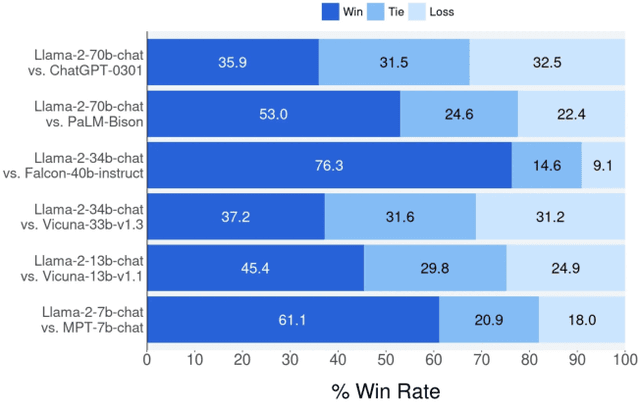

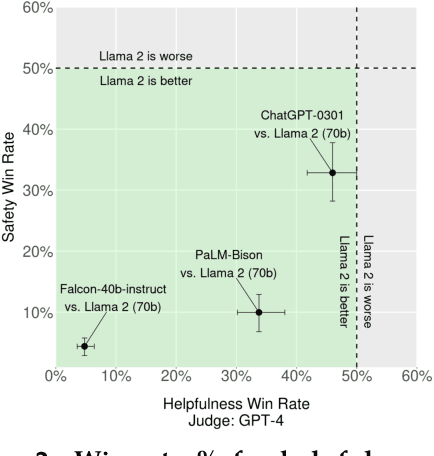

Abstract:In this work, we develop and release Llama 2, a collection of pretrained and fine-tuned large language models (LLMs) ranging in scale from 7 billion to 70 billion parameters. Our fine-tuned LLMs, called Llama 2-Chat, are optimized for dialogue use cases. Our models outperform open-source chat models on most benchmarks we tested, and based on our human evaluations for helpfulness and safety, may be a suitable substitute for closed-source models. We provide a detailed description of our approach to fine-tuning and safety improvements of Llama 2-Chat in order to enable the community to build on our work and contribute to the responsible development of LLMs.
Multilingual Speech-to-Speech Translation into Multiple Target Languages
Jul 17, 2023Abstract:Speech-to-speech translation (S2ST) enables spoken communication between people talking in different languages. Despite a few studies on multilingual S2ST, their focus is the multilinguality on the source side, i.e., the translation from multiple source languages to one target language. We present the first work on multilingual S2ST supporting multiple target languages. Leveraging recent advance in direct S2ST with speech-to-unit and vocoder, we equip these key components with multilingual capability. Speech-to-masked-unit (S2MU) is the multilingual extension of S2U, which applies masking to units which don't belong to the given target language to reduce the language interference. We also propose multilingual vocoder which is trained with language embedding and the auxiliary loss of language identification. On benchmark translation testsets, our proposed multilingual model shows superior performance than bilingual models in the translation from English into $16$ target languages.
Revisiting Machine Translation for Cross-lingual Classification
May 23, 2023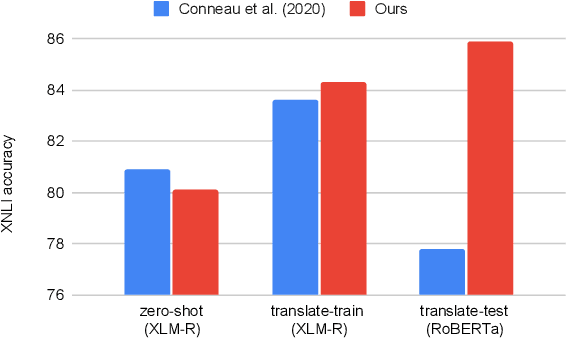
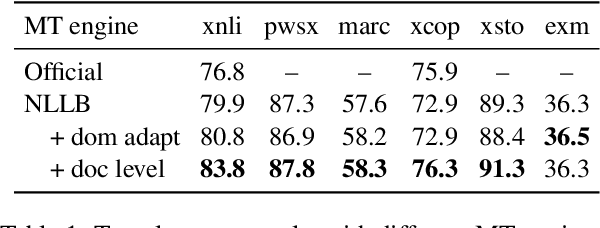

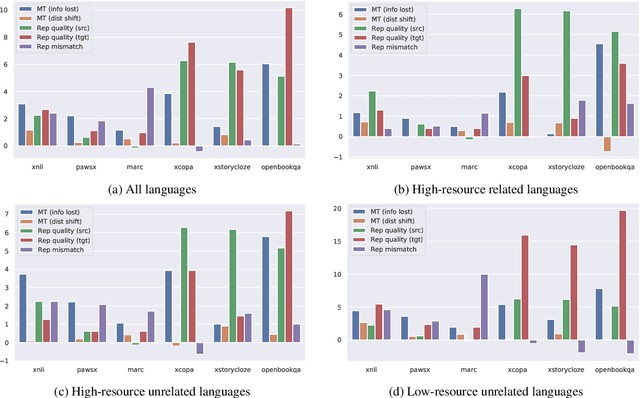
Abstract:Machine Translation (MT) has been widely used for cross-lingual classification, either by translating the test set into English and running inference with a monolingual model (translate-test), or translating the training set into the target languages and finetuning a multilingual model (translate-train). However, most research in the area focuses on the multilingual models rather than the MT component. We show that, by using a stronger MT system and mitigating the mismatch between training on original text and running inference on machine translated text, translate-test can do substantially better than previously assumed. The optimal approach, however, is highly task dependent, as we identify various sources of cross-lingual transfer gap that affect different tasks and approaches differently. Our work calls into question the dominance of multilingual models for cross-lingual classification, and prompts to pay more attention to MT-based baselines.
Towards Being Parameter-Efficient: A Stratified Sparsely Activated Transformer with Dynamic Capacity
May 03, 2023



Abstract:Mixture-of-experts (MoE) models that employ sparse activation have demonstrated effectiveness in significantly increasing the number of parameters while maintaining low computational requirements per token. However, recent studies have established that MoE models are inherently parameter-inefficient as the improvement in performance diminishes with an increasing number of experts. We hypothesize this parameter inefficiency is a result of all experts having equal capacity, which may not adequately meet the varying complexity requirements of different tokens or tasks, e.g., in a multilingual setting, languages based on their resource levels might require different capacities. In light of this, we propose Stratified Mixture of Experts(SMoE) models, which feature a stratified structure and can assign dynamic capacity to different tokens. We demonstrate the effectiveness of SMoE on two multilingual machine translation benchmarks, where it outperforms multiple state-of-the-art MoE models. On a diverse 15-language dataset, SMoE improves the translation quality over vanilla MoE by +0.93 BLEU points on average. Additionally, SMoE is parameter-efficient, matching vanilla MoE performance with around 50\% fewer parameters.
MuAViC: A Multilingual Audio-Visual Corpus for Robust Speech Recognition and Robust Speech-to-Text Translation
Mar 07, 2023Abstract:We introduce MuAViC, a multilingual audio-visual corpus for robust speech recognition and robust speech-to-text translation providing 1200 hours of audio-visual speech in 9 languages. It is fully transcribed and covers 6 English-to-X translation as well as 6 X-to-English translation directions. To the best of our knowledge, this is the first open benchmark for audio-visual speech-to-text translation and the largest open benchmark for multilingual audio-visual speech recognition. Our baseline results show that MuAViC is effective for building noise-robust speech recognition and translation models. We make the corpus available at https://github.com/facebookresearch/muavic.
Language-Aware Multilingual Machine Translation with Self-Supervised Learning
Feb 10, 2023



Abstract:Multilingual machine translation (MMT) benefits from cross-lingual transfer but is a challenging multitask optimization problem. This is partly because there is no clear framework to systematically learn language-specific parameters. Self-supervised learning (SSL) approaches that leverage large quantities of monolingual data (where parallel data is unavailable) have shown promise by improving translation performance as complementary tasks to the MMT task. However, jointly optimizing SSL and MMT tasks is even more challenging. In this work, we first investigate how to utilize intra-distillation to learn more *language-specific* parameters and then show the importance of these language-specific parameters. Next, we propose a novel but simple SSL task, concurrent denoising, that co-trains with the MMT task by concurrently denoising monolingual data on both the encoder and decoder. Finally, we apply intra-distillation to this co-training approach. Combining these two approaches significantly improves MMT performance, outperforming three state-of-the-art SSL methods by a large margin, e.g., 11.3\% and 3.7\% improvement on an 8-language and a 15-language benchmark compared with MASS, respectively
Causes and Cures for Interference in Multilingual Translation
Dec 14, 2022Abstract:Multilingual machine translation models can benefit from synergy between different language pairs, but also suffer from interference. While there is a growing number of sophisticated methods that aim to eliminate interference, our understanding of interference as a phenomenon is still limited. This work identifies the main factors that contribute to interference in multilingual machine translation. Through systematic experimentation, we find that interference (or synergy) are primarily determined by model size, data size, and the proportion of each language pair within the total dataset. We observe that substantial interference occurs mainly when the model is very small with respect to the available training data, and that using standard transformer configurations with less than one billion parameters largely alleviates interference and promotes synergy. Moreover, we show that tuning the sampling temperature to control the proportion of each language pair in the data is key to balancing the amount of interference between low and high resource language pairs effectively, and can lead to superior performance overall.
No Language Left Behind: Scaling Human-Centered Machine Translation
Jul 11, 2022
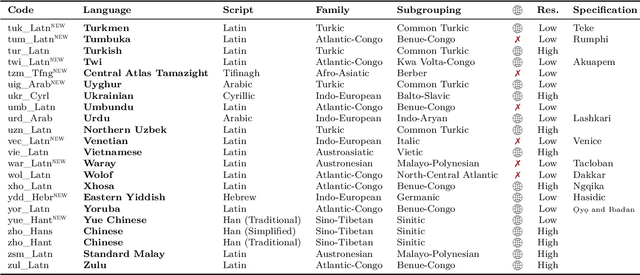
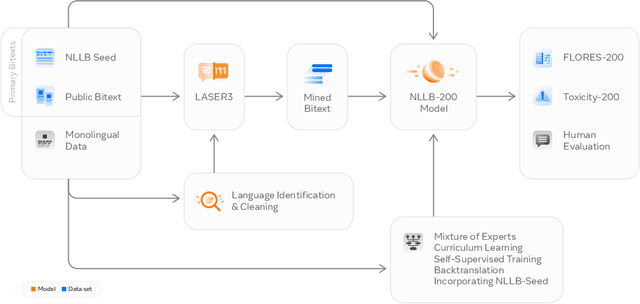

Abstract:Driven by the goal of eradicating language barriers on a global scale, machine translation has solidified itself as a key focus of artificial intelligence research today. However, such efforts have coalesced around a small subset of languages, leaving behind the vast majority of mostly low-resource languages. What does it take to break the 200 language barrier while ensuring safe, high quality results, all while keeping ethical considerations in mind? In No Language Left Behind, we took on this challenge by first contextualizing the need for low-resource language translation support through exploratory interviews with native speakers. Then, we created datasets and models aimed at narrowing the performance gap between low and high-resource languages. More specifically, we developed a conditional compute model based on Sparsely Gated Mixture of Experts that is trained on data obtained with novel and effective data mining techniques tailored for low-resource languages. We propose multiple architectural and training improvements to counteract overfitting while training on thousands of tasks. Critically, we evaluated the performance of over 40,000 different translation directions using a human-translated benchmark, Flores-200, and combined human evaluation with a novel toxicity benchmark covering all languages in Flores-200 to assess translation safety. Our model achieves an improvement of 44% BLEU relative to the previous state-of-the-art, laying important groundwork towards realizing a universal translation system. Finally, we open source all contributions described in this work, accessible at https://github.com/facebookresearch/fairseq/tree/nllb.
 Add to Chrome
Add to Chrome Add to Firefox
Add to Firefox Add to Edge
Add to Edge